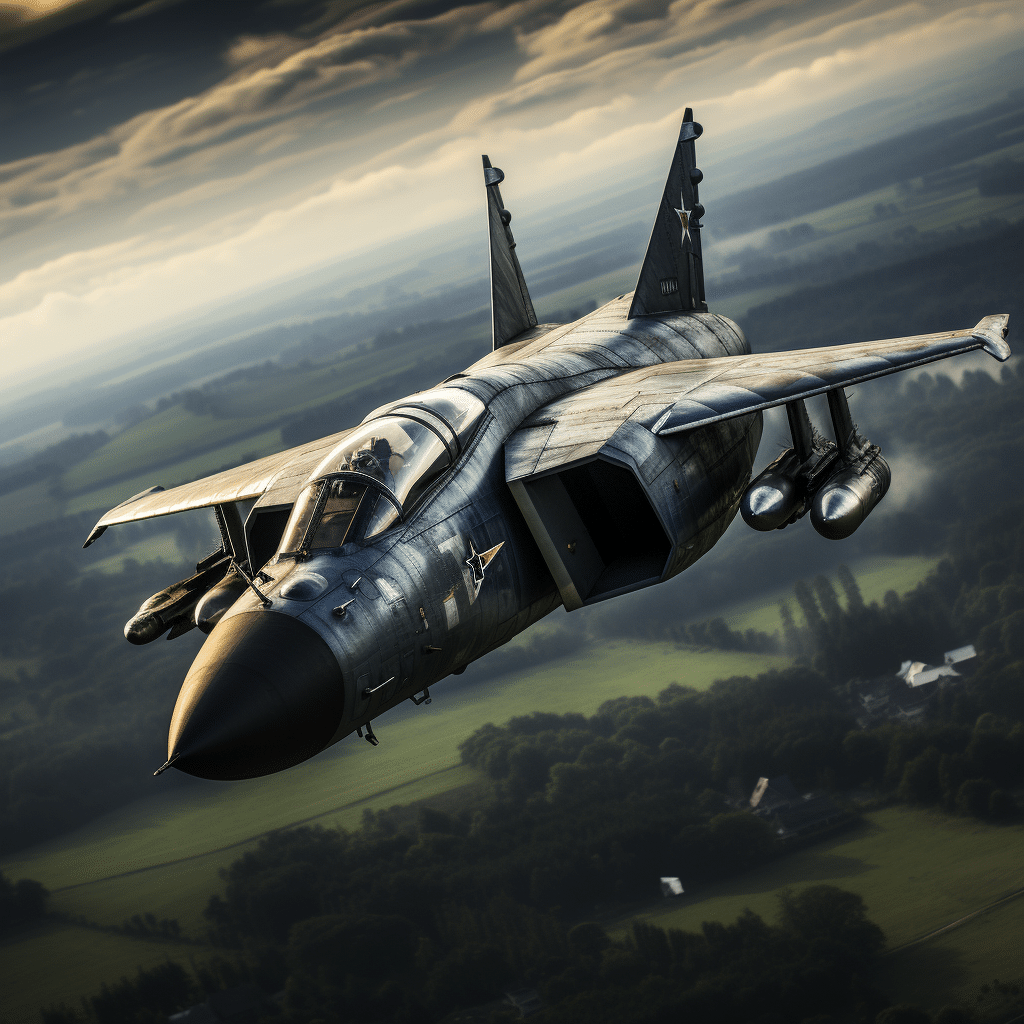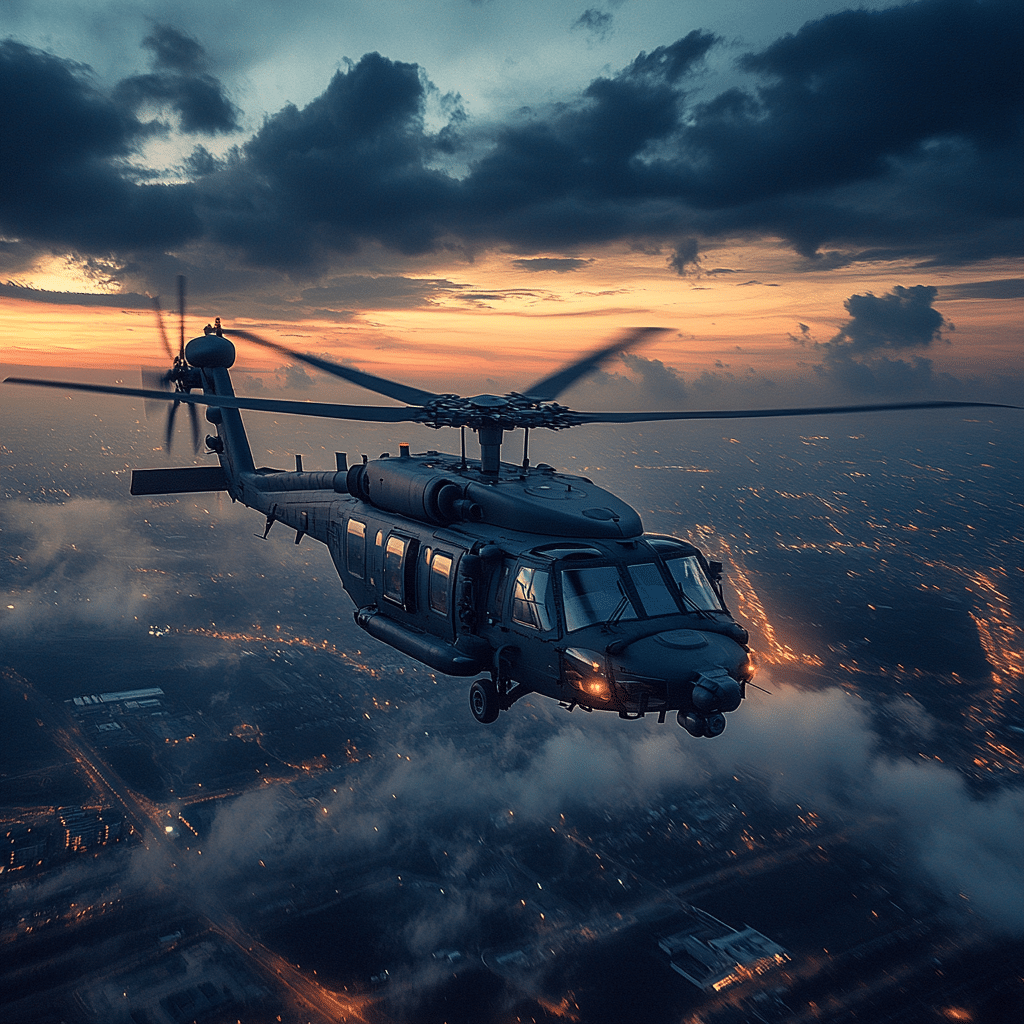The MiG 23, a name that reverberates through the annals of Cold War history, remains a testament to the technological arms race that defined an era. This jet wasn’t just a machine; it symbolized a clash of ideologies encapsulated in steel and thrust. Join us as we dive deep into the evolution and impact of this aerial warrior.
From Sketch to Sky: The Development of the MiG 23
Pre-design Era and Geopolitical Context
In the early 1960s, the world was perched precariously on the brink of nuclear annihilation. The balance of power had a new arbiter, the supersonic fighter jet. In this context, the Soviet Union commissioned the MiG 23, an aircraft intended to match and surpass Western designs.
Design Philosophy and Initial Challenges
Born from the necessity for air superiority, the MiG 23’s design philosophy centered on speed, agility, and firepower. The initial challenges, however, were significant. Adapting to adversarial tactics and technology meant that the MiG had to be versatile as well as formidable.
Breakthroughs and Technological Advancements
The design breakthrough of the MiG 23 was its variable geometry wings. This innovation allowed for unmatched speed and maneuverability. But, ladies and gents, this was just the tip of the technological iceberg that would keep opponents guessing.
Famous Russian Aircraft Mikoyan MiG and MiG

$58.46
The Mikoyan MiG series stands as one of the most celebrated aviation lines in military history, renowned for their combination of speed, agility, and firepower. Originating from the Soviet Union, these aircraft played pivotal roles in numerous conflicts, shaping modern aerial combat tactics. The MiG fighters, especially notable models like the MiG-21 and MiG-29, have been widely exported and used by various air forces across the globe, attesting to their impressive performance and durability. Throughout their existence, MiGs have continually evolved, embracing advanced technology and aerodynamics to stay at the forefront of fighter design.
The MiG-21, nicknamed “Balalaika” for its distinctive shape, is one of the most produced jet fighters in history, with over 11,000 units manufactured. It first soared into the sky in the 1950s, and has since seen action in numerous conflicts, becoming a symbol of Soviet aerospace engineering prowess. Its supersonic speed, simple controls, and robust frame have made it both feared and respected among pilots. The jet remains in service in several countries, underscoring its longevity and the ongoing relevance of the MiG design philosophy.
In contrast, the MiG-29 “Fulcrum” is a testament to the advances in MiG fighter technology, showcasing the power of fourth-generation jet fighters. Introduced in the 1980s, the MiG-29 was designed as a counter to Western aircraft like the F-16, featuring enhanced maneuverability, a state-of-the-art radar system, and a higher thrust-to-weight ratio. It remains a formidable adversary in air-to-air combat and has been adopted by over 30 nations, with updates and modernizations keeping it competitive into the 21st century. The MiG-29 continues to demonstrate that the Mikoyan design bureau’s legacy is alive and thriving, with each model writing a new chapter in the storied history of Russian aircraft.
The MiG 23 Takes Flight: Operational History
Entry into Service and Deployment Scenarios
By 1970, the MiG 23 was swooping into the skies, surpassing expectations. With widespread deployment, it fast became the backbone of Soviet air defense.
Analysis of Combat Roles and Missions
Predominantly an air superiority fighter, the MiG 23 was also tasked with interception and close air support, displaying impressive adaptability in diverse combat roles throughout various theaters of the Cold War.
Comparisons with Contemporaneous Adversaries
The elephant in the room, folks, is the F-15EX. Both jets were apex predators of the sky, yet the MiG 23 battled against more than just adversaries; it struggled against preconceptions of Soviet technology, often in the hands of less-than-elite pilots.

| Category | Information |
|---|---|
| Aircraft Type | Fighter/Interceptor |
| Designation | MiG-23; NATO reporting name: Flogger |
| Manufacturer | Mikoyan-Gurevich |
| First Flight | 1967 |
| Service Entry | 1970 |
| Primary Users (as of 2021) | Angola, Cuba, Democratic Republic of the Congo, Ethiopia, Kazakhstan, Libya, North Korea, Sudan, Syria, Zimbabwe |
| Historical Significance | Technologically advanced for its time; beyond visual range combat capabilities |
| Design Features | Swing-wing configuration; Borrowing concepts from US F-111 and F-4 aircraft |
| Reputation | Unfair due to average pilot skills, tactical misemployment, and downgraded export versions |
| Combat Role | Air superiority, ground attack (MiG-27 Flogger variant) |
| Unit Cost (2023) | USD 1.4 million (used, for privately-owned jet) |
| Notable Variants | MiG-23MLD (improved avionics and weapons systems), MiG-27 Flogger (ground attack version) |
| Retirement | Replaced by MiG-29s in some air forces by the late 1980s |
| Additional Info | World’s only privately owned MiG-23UB crashed in 2023 |
Anatomy of a Legend: MiG-23’s Design Innovations
Swing-wing Functionality and Aerodynamic Characteristics
The MiG 23’s wings were its dance partner, sweeping back for speed, then swinging forward for agility. This engineering marvel defined its aerodynamic prowess.
Avionics and Weaponry: Ahead of its Time?
From radar to missiles, the MiG’s hardware often bordered on prescient. It wasn’t just about what they had, but how they used it.
Engineering Hurdles and Solutions
Make no mistake, challenges abounded. Maintaining such complex machinery was a logistical ballet, and the Soviets danced it admirably.
The MiG-23 Strikes: Cold War Engagements and Impact
Detailed Recount of MiG-23’s Deployment in Hot Spots
“Hot spots” feels like an understatement when talking about the MiG’s battlegrounds. From Middle East conflicts to African skirmishes, the jet was there, often turning the tide.
Stratagems and Tactics: The MiG-23’s Role in Cold War Strategy
The MiG 23 didn’t just fight wars; it played chess. The tactical employment of this aircraft often held strategic implications that reverberated beyond mere dogfights.
Pilot Anecdotes and Mission Critiques
Here’s a snapshot: piloting the MiG was neither for the faint-hearted nor the ham-fisted. It required guts, guile, and a touch of daredevilry—a cocktail these aviators sipped daily.
ACADEMY MIG S Flogger B Model Kit (Model )

$19.99
Unleash your passion for aviation and military history with the ACADEMY MIG S Flogger B Model Kit, a highly detailed replica designed for hobbyists and collectors alike. This exquisite model kit captures the essence of the formidable MIG S Flogger B, renowned for its role during the Cold War era. The kit is meticulously engineered to provide an authentic representation, featuring precisely molded parts and intricate surface details that bring the aircraft’s aggressive lines and unique silhouette to life. Enthusiasts will appreciate the attention to detail, including accurate panel lines and a well-appointed cockpit that beckons a closer look.
The ACADEMY MIG S Flogger B Model Kit is scaled to perfection, allowing for display alongside other models to create a dynamic aerial tableau. This unassembled model offers a challenging and rewarding building experience, with clear, step-by-step instructions to guide hobbyists through the construction process. It includes multiple decal options for various versions of the aircraft, giving modelers the flexibility to customize their build based on historical liveries or their own creative visions. Each piece is designed to fit together seamlessly, resulting in a sturdy and impressive model that captures the power and elegance of the original jet fighter.
Once complete, the ACADEMY MIG S Flogger B Model Kit serves as a striking testament to the engineering and design prowess behind one of history’s most iconic aircraft. It is perfect for display in a home office, on a bookshelf, or in a showcase of military models where it will surely spark conversation and admiration. Whether you’re a seasoned modeler or just beginning in the hobby, this kit promises hours of enjoyment and a delightful addition to any collection. The ACADEMY MIG S Flogger B is not just a model; it’s a piece of history that you can bring to life with your own hands.
A Phoenix Reborn: MiG 23’s Modernized Variants
Upgrades and Life-extension Programs
Time may be undefeated, but man, do the Russians put up a good fight. The upgrades to the MiG, like fine wine and bourne stars, just got better with age.
Conversion to Unmanned Platforms
In the age of drones and autonomous war machines, even a Cold War titan like the MiG finds new life, perhaps flying sans pilot but not sans purpose.
Comparing Performance: Old vs. New
Old guard versus the new. Even amidst beasts like the Su-34, the modernized MiG carved out a niche, proving that age is just a number, and perhaps reputation is just hearsay.

Competitors and Successors: MiG-23 and the Evolution of Aerial Combat
The MiG-23 Versus Su-34: Roles and Performance
The Su-34 may be the hotshot, but let’s not forget who taught it to fly. The legacy of the MiG 23 is evident in its successors’ veins.
Transition to Next-gen Fighters and the Role of the MiG-23 in Modern Warfare
As the torch is passed to next-gen fighters, the MiG’s influence lingers. It’s like Warren Buffett’s investment strategies—timeless and transcendent.
Beyond the Iron Curtain: The Global Footprint of the MiG-23
Export History and International Operators
The MiG went on a world tour, and everyone wanted backstage passes. Sure, sometimes the jet was a bit of a diva, but oh, the performance it gave!
Influence on Global Military Doctrines
The rippling effect of the MiG 23’s capabilities forced a rethink of military strategies worldwide, echoing The Pros of versatility and adaptability in combat aircraft.
Technology Transfers and Geopolitical Ramifications
These weren’t just planes, folks; they were pawns in geopolitics, playing a game more complex than chess on a roller coaster.
MiG Flogger in the Middle East Mikoyan i Gurevich MiG in Service in Algeria, Egypt, Iraq, Libya and Syria, (Middle East@War)

$13.50
The MiG Flogger in the Middle East: Mikoyan i Gurevich MiG in Service in Algeria, Egypt, Iraq, Libya and Syria (Middle East@War) is a comprehensive historical account detailing the deployment and service of the iconic MiG fighter jets in the geopolitically volatile Middle East. The book delves into the strategic importance of these Soviet-era aircraft across five major Arab nations, each with its unique story of acquisition, operation, and engagement within their respective military histories. It offers a captivating exploration of the aircraft’s impact on regional conflicts and the evolution of aerial warfare tactics in this tumultuous area of the world.
From dogfights in the skies of the Yom Kippur War to sorties over the deserts of Libya, this carefully researched work brings to life the drama of MiG operations in a theater that has seen constant action since the jets’ introduction. The author provides rich details on the alliance between Soviet military equipment suppliers and Arab states, examining how this relationship shaped the balance of power in the region. Each chapter is laden with pilot anecdotes, technical specifications, and tactical analyses, creating a vivid narrative that is both educational and engaging for military enthusiasts and historians alike.
Accompanied by an array of photographs, maps, and combat records, this volume captures the importance of the MiG Flogger jets as more than just military hardware, but as a symbol of shifting alliances and the enduring struggle for aerial supremacy. Readers will find in-depth coverage of the modifications, camouflages, and varied operational roles that these aircraft playedâfrom ground attack to air superiority missions. The book stands as a definitive guide to understanding how these Cold War era fighters were operated by Middle Eastern powers and how they influenced the outcome of several key conflicts across the decades.
MiG 23 Today: From Operational Fleet to Aviation Museums
Stories of Retired MiG-23s
Every retired fighter has a story. Take Dan Filer’s MiG 23UB, for instance. Its tale ended not in the skies but as a silent sentinel over the easel of history.
Preservation and Cultural Impact on Aviation History
Museums aren’t just places; they’re time capsules. The MiG 23, encased in glass and reverence, continues to inspire awe as a relic of past dreams and a reminder of human ingenuity.
The Enduring Appeal Among Military Enthusiasts
For the enthusiasts, the MiG remains a crown jewel. Much like Ford Crown Victoria, it has motored past its prime into a revered classic.

When Cold War Tech Meets Modern Warfare
Analyzing Outdated Technologies in Current Conflicts
There’s something poetic about old dogs and new tricks. The MiG 23, in current conflicts, may not have state-of-the-art gadgetry, but it’s still got a bite.
Hypothetical Match-ups: MiG 23 vs. F-15EX
Come on, who wouldn’t pay to see the MiG take on the F-15EX in an alternate universe? It’s like the heavyweight champs of different eras duking it out.
Lessons from the MiG-23 Relevant to Today’s Designers
Today’s aircraft designers can learn a ton from the MiG. Innovation isn’t about reinventing the wheel; sometimes, it’s just giving it a sharper edge.
MiG 23’s Echo in Military Innovation and Culture
The MiG-23’s Contribution to Aviation Tech and Culture
No discussion about aviation technology is complete without mentioning the MiG 23’s sweeping contributions, as indispensable as figuring out Yolo meaning in contemporary slang.
Inspirations Drawn for Modern Aircraft Design
The old bird’s DNA is all over modern designs. It’s as if the MiG whispered in the ears of today’s engineers, imparting its Cold War wisdom.
The MiG-23 in Media and Entertainment
From page to screen, the MiG has been immortalized in pop culture. It’s more than a flying machine; it’s a star with its own billing.
Harnessing the Icon: The MiG-23’s Educational and Symbolic Value
Use in Aerospace Education and Engineering Training
The MiG 23’s relevance extends to academia, where it serves as a cornerstone of aerospace education, much like understanding How old Is Taylor swift is to pop culture literacy.
Symbolism and the Legacy of Cold War Aircraft
The MiG isn’t just metal; it’s a living symbol of a bygone era, a piece of the skies that tells a story. Its legacy is as undeniable as its silhouette against the setting sun.
Future of Vintage Military Craft in Diplomacy and Soft Power
Old warriors like the MiG 23 find new relevance in diplomacy and soft power. Who would’ve thought jets could be ambassadors?
The Ethereal Wings of the MiG-23: An Inspirational Epilogue
Retrospective on the MiG-23’s Journey and Its Place in History
The MiG 23’s flight path through history is a storied odyssey, laden with triumphs, trials, and an unyielding testament to ingenuity.
Ruminations on the Iconography of Military Aircraft
Military aircraft have always been more than mere vehicles of war. They represent the pinnacle of human aspiration, speed, and the conquest of the heavens.
The MiG-23’s Ongoing Influence in Technology and Strategy
The echoes of the MiG’s engines may have faded, but its influence on technology and military strategy continues to ring loud and clear.
For those who dare to dream among the clouds, the MiG 23 stands as an enduring beacon of possibility. It’s more than a jet; it’s a chapter, a character, and a cornerstone of military aviation history.
Unveiling the Mig-23: Trivia & Facts from the Sky
The Birth of a Jetsetter
Well, buckle up, aviation aficionados, ’cause we’re about to take off with some high-flying trivia about the Mig-23, the jet that zipped through the clouds with the same zest as a young lovebird signing up for a Zoosk Login. Born in the thick of the Cold War, this Soviet bird was a sight to behold, taking to the skies for the first time in 1967. With its variable-sweep wing design, it was like the Mig-23 could swipe left on drag and swipe right on speed, ready to mingle with the big boys at top-notch velocity.
At the Beach, the Mig-23 is Still the Talk of the Town
Now, you wouldn’t normally compare a fighter jet to a beach vacation, but hang in there. Imagine the Mig-23 swooping down, dazzling spectators like a star attraction, much like the sought-after Bethany Beach Hotels, which are all the rage during holiday season. Soaring high above expectations, our Cold War celebrity could have easily been the poster child for these hotels, promising an experience that’s anything but ordinary.
Wing It Like You Mean It
Oh, and let’s talk about those wings! The Mig-23’s got this cool party trick – its wings! They’ve got more positions than a yoga instructor. Changing their sweep angle on the go gave the Mig-23 the flexibility of a contortionist, making it as adaptable as a chameleon trying to fit in at a disco. This design wasn’t just for show; it really shook things up in terms of performance, letting this beast balance between agility and speed.
A Legend in Its Own Time
The Mig-23 definitely made its mark, with over 5,000 units churned out like hotcakes! Can you believe it? From the ’70s all the way up to the late ’80s, this bad boy was the pride of the Soviet fleet. The Mig-23 was like that one hit wonder that just keeps on hitting, serving multiple air forces quite gallantly and turning heads while at it.
A Lasting Legacy
Okay, so while the Mig-23 might not be prancing around the skies as much these days, its legacy is rock solid. This jet not only etched its name in the history books but also cemented its reputation as one tough cookie in aerial dogfights and ground attacks. Talk about going down in history with your engines blazing!
And just like that, folks, we’ve looped the loop with the Mig-23. From its inception during frosty political times to its jet-setter lifestyle across the skies, the Mig-23 was more than just a machine; it was a Cold War icon with a story that’s still got plenty of gas in the tank. So, the next time you catch a whisper of its name on the wind, tip your cap to this high-flying marvel. The Mig-23 might just wink back with the roar of its engine!
MiG Flogger in action Aircraft No.

$12.48
The MiG Flogger series represents a line of robust and versatile aircraft that have been a cornerstone in aerial fleets around the world. Aircraft No. from this series showcases the pinnacle of Cold War era aviation technology, with a design that prioritizes speed, agility, and firepower. This particular model, equipped with a powerful radar and an array of weapons including air-to-air missiles and an internal cannon, is a testament to the era’s dogfighting strategies and interdiction roles. The aircraft’s sleek silhouette, punctuated by its variable-geometry wings, allows for both high-speed performance and tactical versatility, making it a formidable adversary in the skies.
Seeing the MiG Flogger in action is an exercise in witnessing aerial prowess, as Aircraft No. slices through the sky with a throaty roar from its turbojet engines. In both offensive and defensive maneuvers, the aircraft demonstrates an exceptional combat radius, able to engage in extended missions without sacrificing performance. Its rugged airframe and advanced avionics package ensure that it’s not only a threat to enemy craft but also a reliable platform for pilots, who can depend on its systems in the most demanding of combat scenarios.
Aircraft No., as an exemplar of the MiG Flogger series, has earned its place in aviation history due to its remarkable service record across numerous air forces and conflicts. Enthusiasts and experts alike continue to marvel at its capabilities during airshows and combat simulations, where it displays the raw power and finesse of Soviet-era military design. Photography and footage of this iconic bird in flight capture the imagination, reminding us of the bygone era of high-stakes aerial duels. Whether as a showpiece or an active participant in historical exercises, the MiG Flogger remains a captivating sight, demonstrating the enduring legacy of this classic fighter jet.
Why was the MiG-23 such a poor aircraft?
Well, buckle up! The MiG-23’s rep takes a bit of a nosedive because it was kinda the black sheep of the aircraft family–folks said it was tricky to fly and maintain. It had its quirks, like being less stable than a one-legged stool, and mixed with a cockpit that was as cramped as a sardine can, it’s no wonder pilots weren’t throwing it a ticker-tape parade.
Is the MiG-23 still flying?
Heck yes, the MiG-23 still skims the skies in a handful of countries! Believe it or not, some air forces can’t resist keeping this old bird airborne, even if it’s about as old school as a rotary phone.
Is the MiG-23 a copy of the F-111?
Nope, the MiG-23 isn’t a carbon copy of the F-111, but you could say it’s kind of like its distant cousin once removed. The MiG took a gander at variable-geometry wings just like the F-111, but that’s where the family resemblance ends.
Was the MiG-23 any good?
Was the MiG-23 any good? Well, that’s like asking if disco had any good tunes – it’s complicated. Some pilots would give it a high five for its top-notch speed and powerful radar, but others would say it’s as easy to handle as a greased pig.
What plane replaced the MiG-23?
The sleek MiG-29 stepped up as the new kid on the block, sidling into the spotlight to replace the MiG-23. It was all, “Outta the way, grandpa!” with its advanced avionics and maneuvers smoother than a buttered biscuit.
Did the MiG-23 see combat?
Yup, the MiG-23 threw its hat into the combat ring, getting down and dirty in various conflicts. From the Middle East to Africa, this bird wasn’t just sitting pretty in the hangar.
What is the difference between the MiG-23 and the F 111?
The MiG-23 and F-111 were like apples and oranges. The F-111 was a heavier, two-seat swing-wing bomber with a big ol’ radar and enough room for a shindig, while the MiG-23 was a lighter, single-seat fighter that was all about that zoom-zoom life.
How far can a MiG-23 fly?
With a fuel tank chock-full of the good stuff, a MiG-23 can hightail it for about 1,150 miles without crying uncle. That’s far enough to make a road trip interesting!
What replaced the MiG 17?
The sharp and snazzy MiG-21 slid into the hangar, ready to school the MiG-17 on what modern jets were all about. The 17 was old news, and the 21 was fresher than a new pair of sneakers.
Why did the F-111 fail?
The F-111 crashed and burned, metaphorically speaking, ’cause it tried to be a jack-of-all-trades but ended up a master of none. Plus, it cost an arm and a leg, and let’s just say taxpayers weren’t throwing it a parade.
Is MiG-23 supersonic?
You betcha, the MiG-23 breaks the sound barrier without breaking a sweat, zooming past Mach 2 like it’s nothing. It’s pretty much the hot rod of the skies.
Why was the F-111 called the pig?
Ha, the F-111 got slapped with the nickname “The Pig” ’cause it could sniff out targets low and dirty, down in the weeds. Plus, it was kinda a hog when it came to guzzling fuel.
What is the fastest MiG ever?
The need for speed? That’d be the MiG-25 Foxbat. This bad boy could tear up the sky at a hair-raising Mach 3.2, leaving other jets in its dust.
Who owned the MiG-23 that crashed?
The MiG-23 that kissed the dirt is a bit of a whodunit. It was flying for Libya, but then, oopsie-daisy, it got a bit lost and belly-flopped into an unsuspecting Italian countryside.
What is the most famous MiG?
Talk about rolling out the red carpet, the MiG-21 is about as famous as it gets. This jet was the life of the party during the Cold War, with more countries on its dance card than a hotshot diplomat.
What is the controversy of MiG planes?
The MiG’s controversy? Where to start! These birds were shrouded in more secrecy than a magician’s cape, and let’s not forget how western powers fretted over their capabilities like anxious cats on a hot tin roof.
What was the most successful MiG plane?
As for the most successful MiG, tip your hat to the MiG-21. This fella was the belle of the ball, with countries lining up to take it for a twirl. It was a veritable rock star, with a production run that just wouldn’t quit.
Who owned the MiG-23 that crashed?
Owned by Libya, that MiG-23 took an unscheduled detour, and boy, was that a whoopsie-doodle! Not exactly the kind of flyby you want to make international headlines for.
What was the MiG-23 made for?
The MiG-23 was born for one thing: flexing its muscles as a frontline fighter. It was all set to go toe-to-toe with anyone brave enough to challenge the Soviet’s aerial might. Basically, it was there to flex and look tough!





















